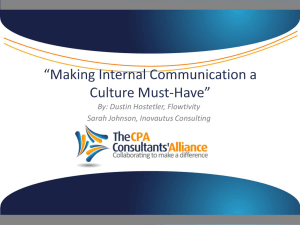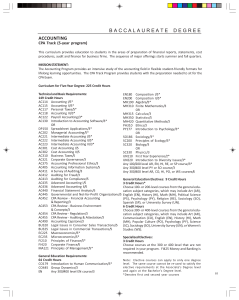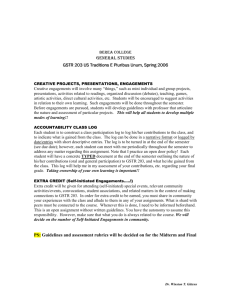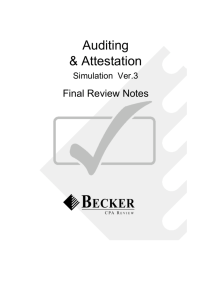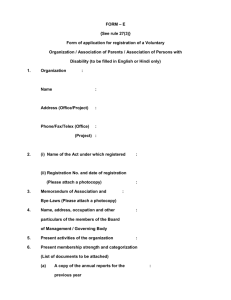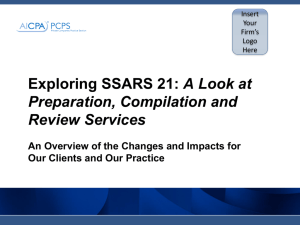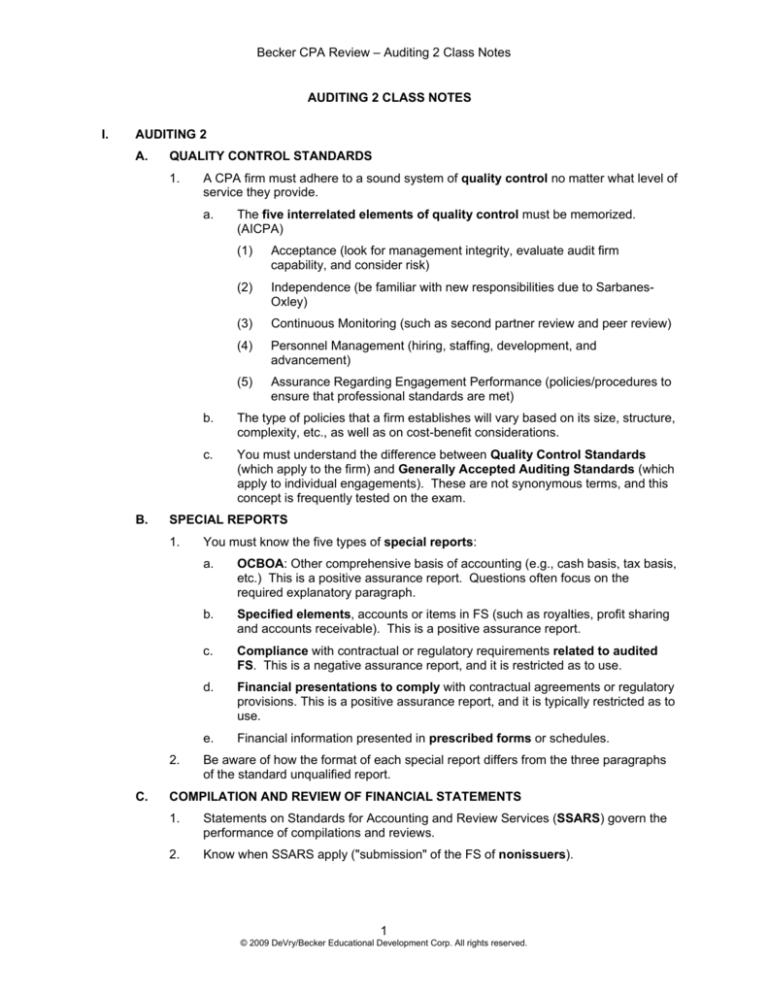
Becker CPA Review – Auditing 2 Class Notes
AUDITING 2 CLASS NOTES
I.
AUDITING 2
A.
QUALITY CONTROL STANDARDS
1.
A CPA firm must adhere to a sound system of quality control no matter what level of
service they provide.
a.
B.
(1)
Acceptance (look for management integrity, evaluate audit firm
capability, and consider risk)
(2)
Independence (be familiar with new responsibilities due to SarbanesOxley)
(3)
Continuous Monitoring (such as second partner review and peer review)
(4)
Personnel Management (hiring, staffing, development, and
advancement)
(5)
Assurance Regarding Engagement Performance (policies/procedures to
ensure that professional standards are met)
b.
The type of policies that a firm establishes will vary based on its size, structure,
complexity, etc., as well as on cost-benefit considerations.
c.
You must understand the difference between Quality Control Standards
(which apply to the firm) and Generally Accepted Auditing Standards (which
apply to individual engagements). These are not synonymous terms, and this
concept is frequently tested on the exam.
SPECIAL REPORTS
1.
2.
C.
The five interrelated elements of quality control must be memorized.
(AICPA)
You must know the five types of special reports:
a.
OCBOA: Other comprehensive basis of accounting (e.g., cash basis, tax basis,
etc.) This is a positive assurance report. Questions often focus on the
required explanatory paragraph.
b.
Specified elements, accounts or items in FS (such as royalties, profit sharing
and accounts receivable). This is a positive assurance report.
c.
Compliance with contractual or regulatory requirements related to audited
FS. This is a negative assurance report, and it is restricted as to use.
d.
Financial presentations to comply with contractual agreements or regulatory
provisions. This is a positive assurance report, and it is typically restricted as to
use.
e.
Financial information presented in prescribed forms or schedules.
Be aware of how the format of each special report differs from the three paragraphs
of the standard unqualified report.
COMPILATION AND REVIEW OF FINANCIAL STATEMENTS
1.
Statements on Standards for Accounting and Review Services (SSARS) govern the
performance of compilations and reviews.
2.
Know when SSARS apply ("submission" of the FS of nonissuers).
1
© 2009 DeVry/Becker Educational Development Corp. All rights reserved.
Becker CPA Review – Auditing 2 Class Notes
3.
The auditor is required to have an understanding with the client regarding the service
being provided, and this understanding should be documented. An engagement
letter is the best way to document the understanding.
4.
Compilation – the accountant prepares financial statements without expressing any
assurance.
a.
b.
5.
6.
The accountant must perform the following procedures for this type of
engagement:
(1)
Establish an understanding with the client.
(2)
Obtain knowledge of the industry and the business.
(3)
Read the financial statements.
(4)
If fraud/illegal acts come to the accountant's attention, consider the effect
on the financial statements.
(5)
Draft the compilation report – you must commit to memory the standard
report for a compilation, and you must know how to modify the standard
report if disclosures are omitted or if there are departures from GAAP.
A report is not required if FS are not expected to be used by a third party (but
an engagement letter must be used instead).
Review – accountant uses inquiry and analytical procedures as a basis for
expressing limited assurance on the financial statements.
a.
The accountant must be independent in order to perform a review.
b.
The accountant must perform the following procedures for this type of
engagement:
(1)
Establish an understanding with the client.
(2)
Obtain knowledge of the industry and the business.
(3)
Make inquiries of appropriate individuals.
(4)
Perform analytical procedures.
5)
Read the financial statements.
(6)
If fraud/illegal acts come to the accountant's attention, consider the effect
on the financial statements.
(7)
Obtain a client representation letter from management.
(8)
Draft the review report – you must commit to memory the standard report
for a review, and you must know how to modify the standard report if
there are departures from GAAP.
c.
During a review of a nonissuer, the auditor is not responsible for testing internal
control, performing audit tests, or assessing fraud risk.
d.
Reporting on only one FS is okay.
e.
A change in the type of engagement is okay if it is for the right reasons (e.g.,
change in client requirements).
Reporting on Comparative Financial Statements
a.
Know how to report when there is a service upgrade or a service downgrade.
b.
Know how to handle situations in which a previously issued report needs to be
revised.
2
© 2009 DeVry/Becker Educational Development Corp. All rights reserved.
Becker CPA Review – Auditing 2 Class Notes
D.
E.
c.
Be aware of the issues that arise when a predecessor auditor is involved.
d.
Know how to report when one period is audited and the other period is not.
REVIEW OF INTERIM FINANCIAL INFORMATION
1.
Note that this typically applies to public companies (issuers) and falls under auditing
standards (PCAOB standards), not SSARS.
2.
The accountant must perform the following procedures for this type of engagement:
a.
Establish an understanding with the client.
b.
Obtain sufficient knowledge of the entity's business and its internal control
(note this is different than a review under SSARS).
c.
Make inquiries of appropriate individuals.
d.
Perform analytical procedures.
e.
Read financial information, board minutes, etc.
f.
Obtain a client representation letter from management.
g.
Communicate results to management and the audit committee.
h.
Draft the review report - You must commit to memory the standard report for a
review (note that it is different than the review report under SSARS).
3.
Know how to modify the standard report if there are departures from GAAP.
4.
Comfort Letter
a.
A comfort letter is typically addressed to an underwriter, and covers the period
from the last audit to the registration date.
b.
The auditor is required to perform a review of the interim financial information.
c.
A comfort letter:
(1)
Provides negative assurance with respect to unaudited financial
statements.
(2)
Is restricted and not for the general public.
(3)
Provides positive assurance regarding the auditor's independence.
ATTEST ENGAGEMENTS
1.
An attest engagement is one in which a CPA is engaged to issue an examination,
review, or agreed-upon procedures report on subject matter, or on an assertion about
the subject matter, that is the responsibility of another party (typically management).
2.
The standards for attestation engagements are very similar to GAAS, but not
identical.
a.
There are five general standards: training and proficiency; independence,
performance/due professional care, professional knowledge of subject matter,
and judgment as to whether the assertion is capable of evaluation.
b.
There are two fieldwork standards: planning and supervision, and evidence.
c.
There are four reporting standards: identify the assertion/subject matter and
the type of service, express a conclusion, disclose any reservations about the
engagement, and (in certain circumstances) restrict use of the report.
3
© 2009 DeVry/Becker Educational Development Corp. All rights reserved.
Becker CPA Review – Auditing 2 Class Notes
3.
4.
Statements on Standards for Attestation Engagements (SSAE) are applicable for
attestation engagements. Attestation services include those related to:
a.
Agreed-upon procedures
b.
Financial forecasts and projections
c.
Pro-forma financial statements (restricted use)
d.
Internal control over financial reporting (covered in A5)
e.
Compliance engagements
f.
Management's Discussion and Analysis
Trust Services
The following trust services are also considered attest engagements.
a.
WebTrust Engagement – assessing a website
b.
SysTrust Engagement – assessing a system
5.
Like GAAS audits, attest engagements require an understanding with the client,
appropriate documentation, and inquiry regarding subsequent events.
6.
A written assertion and a management representation letter are required for
examinations and reviews.
7.
Agreed-Upon Procedures Engagements
a.
b.
8.
The following conditions must exist for an auditor to accept this type of
engagement:
(1)
Independence of the accountant.
(2)
Agreement of the parties as to what procedures are going to be applied,
the criteria to be used, etc.
(3)
The subject matter must be capable of consistent measurement.
(4)
The specified party takes responsibility for the sufficiency of the
designated procedures.
(5)
Use of the report is restricted to the specified parties.
(6)
The client (or in some cases a third party) is responsible for the subject
matter.
(7)
A summary of significant assumptions is included if prospective FS are
involved.
There are various reporting requirements, including a list of procedures
performed and findings obtained, a statement that the specified party is
responsible for the sufficiency of the procedures performed, a disclaimer of
opinion, and a restriction on use.
Prospective Financial Statements
a.
Financial forecast – know the definition ("best guess") and that forecasts are
available for general (or restricted) use.
b.
Financial projection – know the definition ("what would happen if") and that
projections are restricted use.
4
© 2009 DeVry/Becker Educational Development Corp. All rights reserved.
Becker CPA Review – Auditing 2 Class Notes
c.
The auditor can perform the following types of engagements with regard to
prospective financial statements.
(1)
Compilation engagement – disclaim an opinion, include caution about
achievability, and state that the accountant has no responsibility to
update.
(2)
Examination engagement – two parts to opinion: FS presented in
conformity with guidelines and assumptions provide a reasonable basis
for FS. Also, include caution about achievability, and state that the
accountant has no responsibility to update.
(3)
Agreed-upon procedures – see item 7b above. Also, include caution
about achievability and state that the accountant has no responsibility to
update.
Note that a review is not an option.
d.
9.
Partial presentations of prospective information exclude certain essential
elements and are not appropriate for general use.
Other Attest Engagements
a.
Pro-forma Financial Statements – show the effect a hypothetical transaction
would have had on past FS – these are not prospective FS.
(1)
These statements may either be examined or reviewed.
(2)
The report should reference the financial statements from which the
historical financial information was derived.
b.
Compliance Attestations – an agreed-upon procedures engagement or an
examination may be performed.
c.
Management's Discussion and Analysis (MD&A) – an examination or a
review may be performed.
5
© 2009 DeVry/Becker Educational Development Corp. All rights reserved.


